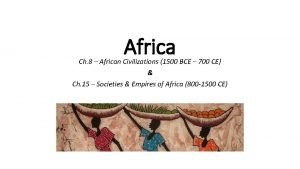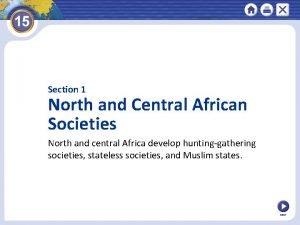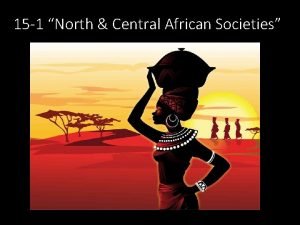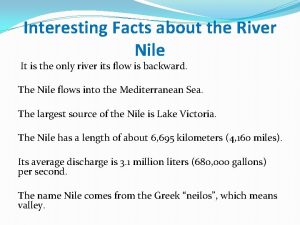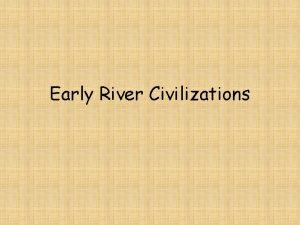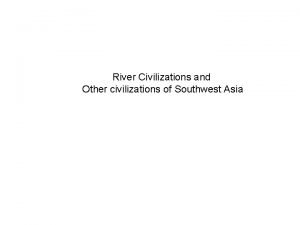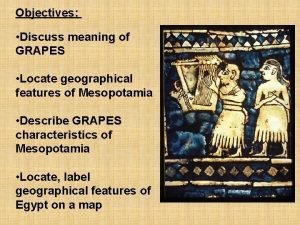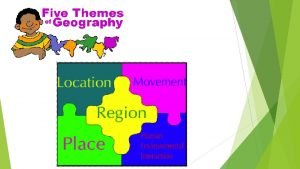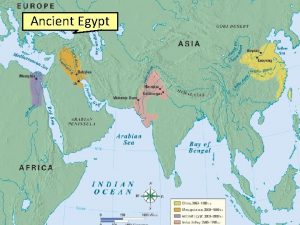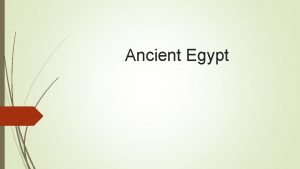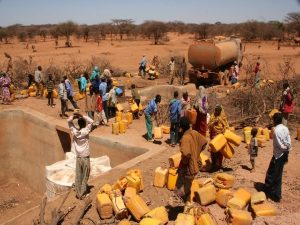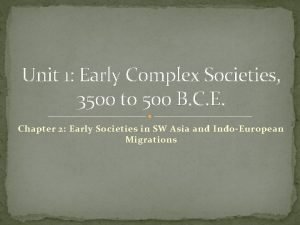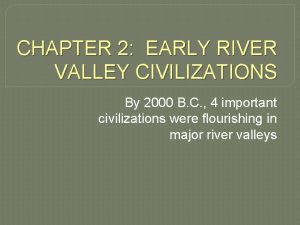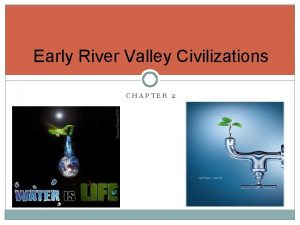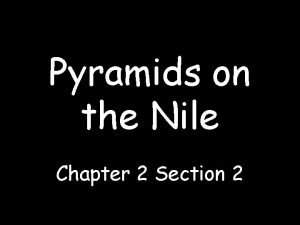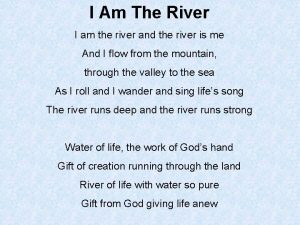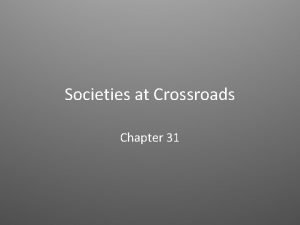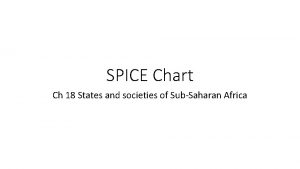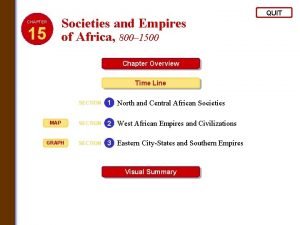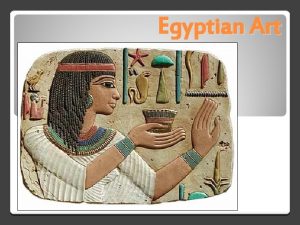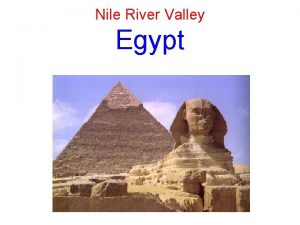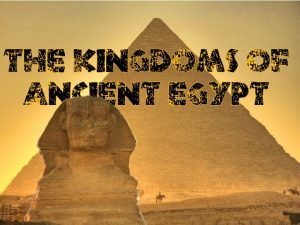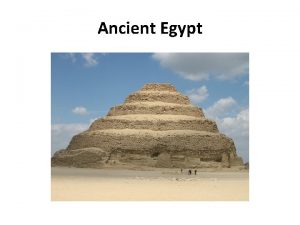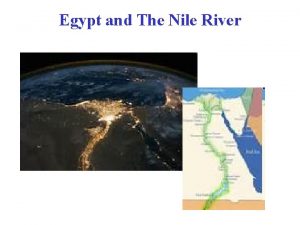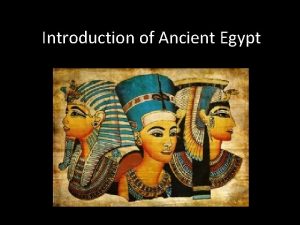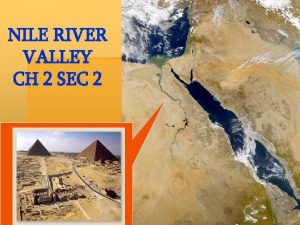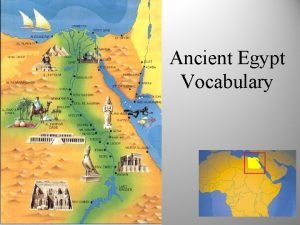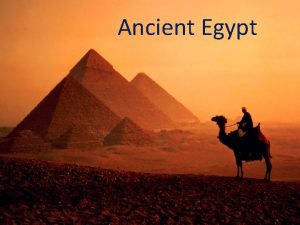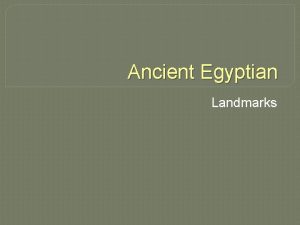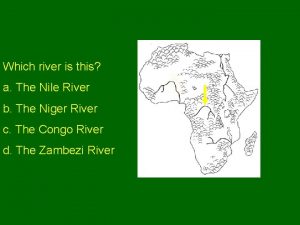Chapter 3 Early African Societies The Nile River
































- Slides: 32

Chapter 3 Early African Societies

The Nile River �The Nile is the longest river in the world. o 4, 160 miles in length �The Nile runs South to North (One of only 2 rivers in the World!) �Prior to completion of the Aswan Dam in 1968 CE, The Nile’s accumulated waters annually flooded the plains downstream. �When the waters receded they left behind a lay of rich, fertile muck, and those deposits supported a remarkably productive agricultural economy throughout the Nile River valley.

Advantages of the Nile �The South-North flow allows travel and transportation of goods. �Yearly floods create fertile soil �Deposits of granite, sandstone, and limestone �Warm weather allows different kinds of crops to grow. �Both Egyptians and Nubians relied heavily on agriculture by 5000 BCE. �Because of the ease of growing crops, the Greek historian Herodotus (Father of History) called Egypt “The Gift of the Nile”.

First Steps to Civilization �Pastoral nomads settle about 5000 BCE �A form of writing called hieroglyphics develops around 3000 BC �Paper is made from papyrus �Egyptian hieroglyphics translated through the Rosetta Stone


The Egyptian Kingdoms �Two distinct cultures develop, Upper and Lower Egypt �Menes is the first ruler to unite Egypt into one kingdom-3100 BC �Years later, the term Pharaoh is created to honor him and the rulers. It means “great house” �Unlike Mesopotamia, Egypt developed a strong central government

The Old Kingdom, 2680 -2180 BC �Egyptian society is split into two social classes: o Lower = Peasants and farmers o Upper= Royal family, priest, scribes, and government officials �Great Pyramids and the Sphinx are constructed around 2500 BC. �The end of the Old Kingdom comes when the Pharaohs grow weak and the nobles strong, which leads to civil war. �Drought weakened Pharaohs’ claim to be a god �Memphis was the capital city


The Middle Kingdom, 2040 -1780 BC �Mentuhotep II eventually took power; reuniting Upper and Lower Egypt, strengthened central government �Pharaohs wanted to be viewed as wise and caring �Huge irrigation projects were completed to turn more desert into farmland �Expanded borders �Invasion of the Hyksos ended the Middle Kingdom

Hyksos Invasions �A foreign people called the Hyksos invade �Not much is known about the Hyksos except that they reigned in the lower kingdom for around 100 years. �What little we do know about the Hyksos is that they used bronze weapons and used horses and chariots during warfare. �More wars and the driving out of the Hyksos lead to the New Kingdom

The New Kingdom, 1570 -1080 BC �Pharaohs have absolute power and are treated as gods �Akhenaton tried to make Egypt monotheistic and worship Aten (1350). This disrupted the whole Egyptian society. Upon his death, the old religion was restored. �Rames the Great was the best pharaoh in Egyptian history. He took power in 1290 BCE �Expanded borders, more temples �Rames brought Egypt to it’s height, but attracted a lot of attention. After his death, his successors were unable to maintain his territory. �Hittites, Libyans, Assyrians, Persians, Macedonians, Rome

Decline of Egypt �Ramses II is the last of the powerful pharaohs �Egypt weakened by foreign invading forces. �Later after the Greeks and Romans invade, the Pharaohs will rule again, but in name only.

Egyptian Society �Royal families, nobles, priests ( all landowners) �Artisans �Farmers �Slaves �All classes except slaves were equal before the law �Egyptian women could own property, make contracts, divorce, and sue others �Polytheistic, mummification �Egyptian culture changed very little over the course of 3, 000 years

Egyptian Contributions �Hieroglyphics �Papyrus �Book of the Dead �Pyramids (math and engineering) �Fractions and geometry � 365 day calendar �Mummification helped doctors learn about the human body- set broken bones, stitches, amputations



Nubia, Axum and Kush �Developed south of Egypt, traded across the Red Sea �Nubia copied a lot of Egyptian ways, mostly farmers �Kush would replace Nubia (1000 BCE-663 BCE) �Traded with Roman empire, India, and Arabia �Axum came to power in modern day Ethiopia (100 CE) �Successful trading colony �Interaction with Romans allowed many Axumites to convert to Christianity. This allowed for Ethiopia to remain Christian for many centuries; even after Islam converted most of Africa


Chapter 4 Early Societies in South Asia

Harappan Society and Its Neighbors, ca. 2000 B. C. E. 20

Foundations of Harappan Society �The Indus River �Silt-enriched water from mountain ranges �Major society built by Dravidian peoples, 3000 -2500 B. C. E. �Cultivation of cotton before 5000 B. C. E. , early cultivation of poultry �Decline after 1900 B. C. E. �Major cities: Harappa (Punjab region) and Mohenjo-daro (mouth of Indus River) � 70 smaller sites excavated (total 1500) 21

Mohenjo-Daro Ruins �Population about 40, 000 �Regional center �Layout, architecture suggests public purpose �Broad streets, citadel, pool, sewage �Standardized weights evident throughout region �Specialized labor �Trade 22



Harappan Society and Culture �Evidence of social stratification �Dwelling size, decoration �Harappan civilization: influence on later Indian culture �Statues, figurines, and illustrations reflect a tradition of art and metallurgy �Venerated goddesses of fertility 25

Mysterious End of Harappan Civilization �Reasons for disappearance unclear �Excessive deforestation, loss of topsoil �Earthquakes? �Flooding? � Evidence of unburied dead �Disappearance by 1500 B. C. E. 26

The Early Aryans �Indo European pastoral nomads used horses to take over northern India in 1500 BCE �Aryan tribe was divided into clans which means no central government �Pastoral economy: sheep, goats, horses, cattle �Cattle not sacred until many centuries later �Sanskrit: sacred tongue �Prakrit: everyday language, evolved into Hindi, Urdu, Bengali � 1200 BCE a writing system was developed 27

The Vedic Age �Conflicts between Aryans and indigenous dasas (“enemies, ” “subjects”) �Aryans fighting Dravidians �Also Aryans fighting each other �Chiefdoms: rajas �Early concentration in Punjab, migrations further south �Development of iron metallurgy �Increasing reliance on agriculture �Tribal connections evolve into political structures 28

Patriarchy in Ancient Indian Society �“Rule of the father” �A social order that stood alongside the caste system, and varna hierarchy �Enforced in the Lawbook of Manu �Women to be subject to fathers, husbands, sons �Women’s most important duties to bear children and maintain wholesome homes 29

Aryan Religion �The Vedas; Sanskrit for knowledge �Collection of hymns, poems and songs �The Rig-Veda, sheds light on Aryan society �Major deity of Rig Veda: Indra, war god �Elaborate ritual sacrifices to gods �Role of brahmins important �Ca. 800 B. C. E. some movement away from sacrificial cults �Mystical thought, influenced by Dravidians 30

Varna: The Caste System �Origins in Aryan domination of Dravidians �Brahmin, priest �Kshatriya, warrior �Vaishya, merchant �Shudra, serf �“Untouchables” �Jati system of subcastes �Related to urbanization, increasing social and economic complexity 31

Teachings of the Upanishads �Texts that represent blending of Aryan and Dravidian traditions �Composed 800 -400 B. C. E. , some later collections until thirteenth century C. E. �Brahman: the universal soul �Samsara: reincarnation �Karma: accounting for incarnations �Moksha: mystical ecstasy �Relationship to system of Varna �Would be the basis of Hinduism 32
 Aksum had access to the red sea blue nile and white nile
Aksum had access to the red sea blue nile and white nile North and central african societies
North and central african societies West african societies around 1492
West african societies around 1492 North and central african societies
North and central african societies Six cataracts of the nile river
Six cataracts of the nile river 5 facts about the river nile
5 facts about the river nile River valley civilization
River valley civilization Nile river
Nile river Leon ridgeway
Leon ridgeway Kush nile river
Kush nile river The nile river is the lifeline of
The nile river is the lifeline of Language egypt
Language egypt Absolute and relative direction
Absolute and relative direction A section of the nile river with rapids and rocky terrain
A section of the nile river with rapids and rocky terrain What is the relative location of egypt
What is the relative location of egypt Nile river
Nile river Ancient egypt advanced cities
Ancient egypt advanced cities Wheres the nile river
Wheres the nile river The picture tell us that
The picture tell us that Frontalism in egyptian art
Frontalism in egyptian art Nile river basin
Nile river basin Nile river basin
Nile river basin Monotheism
Monotheism River valley civilizations def
River valley civilizations def Chapter 2 early river valley civilizations
Chapter 2 early river valley civilizations Chapter 2 section 2 pyramids on the nile worksheet answers
Chapter 2 section 2 pyramids on the nile worksheet answers Tukwila
Tukwila I am the river and the river is me
I am the river and the river is me Early cpr and early defibrillation can: *
Early cpr and early defibrillation can: * Chapter 31 societies at crossroads
Chapter 31 societies at crossroads Africa spice chart
Africa spice chart Chapter 15 societies and empires of africa
Chapter 15 societies and empires of africa Eli ghazel
Eli ghazel
